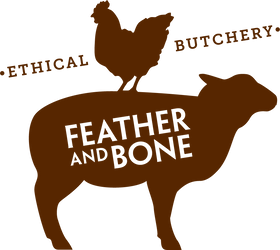AVAILABILITY, CUTS & STORAGE
WHOLE BODIES
We bang on about it all the time but, in case you hadn’t noticed, we buy whole bodies – NO BOXED MEAT.
That means we’ve got the whole body to sell – nose to tail and everything in between. Including cuts that many of us, these days, have barely heard of, let alone know how to cook. This poses some challenges but also provides some excellent opportunities.PRODUCT AVAILABILITY
Ditto with different sizes or special packing. We’re happy to customise your order if what’s listed here isn’t quite what you’re after. We can’t offer all of the available cuts that whole bodies yield online, so what you see listed here is the greatest hits collection. The rest of it is available at our place when you come over or you can just ask.
It’s also worth saying that there are lots of variables in what we source – different farming practices, geography and different breeds that grow at varying rates and weights. Not to mention the fact that all the animals we source are entirely pasture-raised which brings the weather, in all its unpredictable glory, into the equation.
All of this means that, while we do our best to provide you with a consistent product, we’re also committed to supporting producers who work in system with a lot of built-in variability so we ask for your patience if you can’t see what you want. If we can’t get it now, we’re bound to be able to get it soon.
Find out more about our approach.
Whole Body Challenges
-
We have to sell the whole body Not just the steak and chops, but also the ribs and shanks and livers and flanks and hocks and heads, to make a living.
-
Convince you to live dangerously This means we have to encourage you to occasionally move outside your comfort zone and try cooking up a storm of lamb breast instead of lamb rack. You can see where we’re going with this.
-
Not enough to go round In winter, everyone wants lamb shanks and osso buco and in summer everyone wants chicken wings and steaks. The animal, however, doesn’t grow extra legs or lose them to correspond with consumers’ seasonal demands. You don’t have to be Einstein to figure the maths on that particular little problem.
This is why most butchers buy boxes of whatever meat their customers want for the season.
-
Mother Nature at work Our farmers do their best to produce whole bodies of a consistent weight, size and fat score but farming pasture-raised animals isn’t an exact science.
So, the whole lamb we get this month could be 10 kg heavier than the whole lamb we got last month. This means all the cuts from that lamb will be bigger than the ones we advertised last month.
This is tricky when you’re selling the meat online for a flat price and explains why we often give you the weight of an item, rather than the quantity.
Whole Body Opportunities
-
A world of new cuts You get to open your hearts and minds to a fabulous array of different culinary adventures with cuts like lamb breast, beef skirt and pork medallion not to mention the whole retro thing with gammon and corned beef.
-
Real yield Primary cuts like beef eye fillet are the most popular and familiar. But beef eye fillet, for example, only comprises about 2% of the whole carcass. You'd never know it, though, because butchers tend to buy boxes of cuts that they know are popular with the punters so there's always plenty of cheap eye fillet available. Not at our place, however.The good thing about this is that there’s about 98% left over that is also delicious and, importantly, cheaper. If you’re interested in supporting the alternative to intensive farming, you need to learn to love the secondary cuts.
-
Greater choice Choosing to buy whole bodies allows us to source from small farms with superb quality produce that can only afford to sell the whole animal. This means more diversity in breeds and growing practices which means more options for you.
- Quality control It also means that we have greater quality control and we can be absolutely sure we’re getting what we ordered. In addition, there are few better ways to determine the health and vitality of an animal than by scrutinising the organs, which you only get if you buy the whole animal.
CUTS
Knowing which cut to use when can have a big impact on your bottom and your bottom line.
Cooked the right way, beef skirt or lamb breast can be just as gorgeous as a plump chicken breast and have your dinner party guests cooing with pleasure. You can feel doubly smug because you’ll have paid at least a quarter what you might have spent on beef eye fillet, for example.
Which isn’t to say that beef eye fillet isn’t melt-in-the-mouth delicious - in the right place at the right time with the right budget. However, as you’ll see in the diagrams provided, the eye fillet is only about 2% of the carcass and, as such, should really only be eaten about 2% of the time. More about all that below in the ‘cooking’ section.
Here are links to some diagrams of the usual cuts derived from cows, sheep and pigs. You can apply this anatomy to other animals, including yourself.
STORAGE
Vacuum packaging
We'd love to use less plastic and we're patiently waiting for the day that a strong, bio-degradable plastic that can withstand intense heat, cold and pressure eventuates. However, as things stand, we do vacuum pack quite a lot of our product for delivery because it's the best way to keep things fresh for the longest period and avoid freezer burn.
But, although they're pretty strong, occasionally the vacuum seal on a bag is compromised resulting in oxidisation. It's always wise to check your packages when you're putting them in the fridge or freezer to make sure they haven't popped.
Fresh Poultry
Like fish, poultry is best eaten as fresh as possible.
If it’s cryovaced (vacuum sealed in plastic), it’ll last for four or five days but, if you know you won’t get to it for a few days, we recommend taking your poultry out of the plastic for storage. Put it in the fridge on a plate lined with a paper towel and loosely covered with a plastic bag to stop it drying out.
Otherwise, you’re better off freezing it in the vacuum sealed bag which protects it from freezer burn and then, when you’re ready to use it, letting it thaw slowly in the fridge.
If it’s not cryovaced, take it out of the bag you brought it home in. Put it on a plate lined with a paper towel and loosely cover with a plastic bag in the fridge.
Cook within a few days.
Fresh Pork, Veal and Lamb
These meats are more robust than poultry but not as long-lasting as beef.
If your meat is cryovaced (vacuum sealed in plastic), it should last for at least a week in your fridge. Any longer and we suggest you freeze it.
The day before you plan to cook it, take it out of the plastic and put it back in the fridge on a plate lined with a paper towel and loosely covered with a plastic bag to stop it drying out. It may have a slight odour from being packed in plastic for a while but the smell should evaporate once it’s had time to air.
If it’s not cryovaced, take it out of the bag you brought it home in. Put it on a plate lined with a paper towel and loosely cover with a plastic bag in the fridge.
Cook within a few days.
Fresh Beef
If your beef is cryovaced (vacuum sealed in plastic), it will last up to three weeks. Our beef is dry aged (hanging in our cool room) but a lot of beef is ‘wet aged’ in plastic for three weeks or longer.
The day before you plan to cook it, take it out of the plastic and put it back in the fridge on a plate lined with a paper towel and loosely covered with a plastic bag to stop it drying out. It may have a slight odour from being packed in plastic for a while but the smell should evaporate once it’s had time to air.
If it’s not cryovaced, take it out of the bag you brought it home in. Put it on a plate lined with a paper towel and loosely cover with a plastic bag in the fridge.
Cook within a few days.
Cured Meats
Cured meats are, well, cured. That means by definition that they’re treated to last, usually with time-honoured processes that were invented way before we had cold- storage on tap. So your bacon and ham is very robust and will last months if properly stored.
Of course, once sliced, cured meats won’t last as long because there’s a greater surface exposed to oxidization. Once you’ve opened your pack of sliced bacon, salami or ham, wrap the remainder in grease proof paper and put it into a sealed container in the fridge so it doesn’t dry out.
If you’ve got an unsliced chunk, just wrap the sliced section in grease proof paper and refrigerate.
COOKING - WHICH CUTS TO USE
Whole forests, real and virtual, have been devoted to tomes about cooking meat and most of us have bookshelves groaning with them. So if you're looking for heavy detail, please refer elsewhere. Otherwise, here are a few basic guidelines that we follow.
Slow Cooking
A muscle like beef chuck (neck) or round (front thigh) does a lot of work so the meat is highly flavoured but interspersed with tough sinews that will give your dentures a good work out if they’re not properly cooked.
These sorts of cuts – known disparagingly and unfairly as ‘secondary’ cuts - need to be braised or roasted low and slow for a long time to dissolve the fibres and give that gorgeous flavour a chance to shine.
Some secondary cuts, like beef blade, live a double life and can also be delicious cut into thin steaks and quickly seared on a very high heat or used for stir frying.
But make sure the heat is high and don’t allow it to stew when you’re frying or grilling - unless you have a thing for eating boot leather.
Fast Cooking
Lean or delicate cuts like loin and fillet have an inflated sense of self importance because we call them ‘primary’ cuts. Some folks think that so-called ‘secondary’ cuts are actually much more appealing than the more expensive primary muscles which are leaner and more tender but generally have less depth of flavour because they don’t work as hard.
In fact, if you haven't been living under a rock for the last five years, you'll know that slow-cooked secondary cuts have become the darlings of the Paleo and wholefoods crowd and we sometimes find there's more demand for lamb shoulder than lamb cutlet. Poor little things.
Be careful not to over-cook your primaries - lean, delicate meat doesn’t need much cooking.
It’s best served rare or medium rare and deserves plenty of rest so the meat can settle after cooking and before serving.



